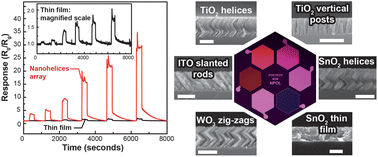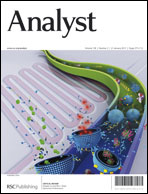A near single crystalline TiO2 nanohelix array: enhanced gas sensing performance and its application as a monolithically integrated electronic nose†
Abstract
We present high performance gas sensors based on an array of near single crystalline TiO2 nanohelices fabricated by rotating oblique angle deposition (OAD). The combination of large surface-to-volume ratio, extremely small size (<30 nm) comparable to the Debye length, a near single crystallinity of TiO2 nanohelices, together with the unique top-and-bottom electrode configuration hugely improves the H2-sensing performance, including ∼10 times higher response at 50 ppm, approximately a factor of 5 lower detection limit, and much faster response time than the conventional TiO2 thin film devices. Beyond such remarkable performance enhancement, the excellent compatibility of the OAD method compared with the conventional micro-fabrication technology opens a new avenue for monolithic integration of high-performance chemoresistive sensors to fabricate a simple, low cost, reliable, yet fully functional electronic nose and multi-functional smart chips for in situ environmental monitoring.

- This article is part of the themed collection: Smart Surfaces 2012: From Light To Life

 Please wait while we load your content...
Please wait while we load your content...